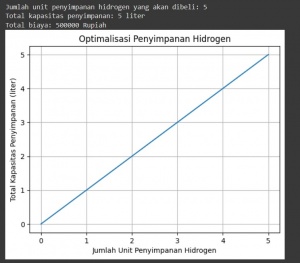Difference between revisions of "Alvin Tanoto"
Alvinntanoto (talk | contribs) |
Alvinntanoto (talk | contribs) (→Python Code For the Case Above) |
||
| Line 62: | Line 62: | ||
| − | == | + | == Final Report of Design & Optimization of Pressurized Hydrogen Storage == |
---- | ---- | ||
Revision as of 00:25, 5 June 2023
HAI, ALL Perkenalkan nama saya Alvin Tanoto akrab dipanggil alvin dari mesin angkatan 2021 dengan NPM 2106640064, disini siap menimba ilmu! 😁😁👍👍
Design & Optimization of Pressurized Hydrogen Storage and the Safety Variable in it
A 1-liter hydrogen storage design that is budget-friendly must carefully take into account a number of variables. Here are some ideas to assist you come up with a design concept and optimize it for hydrogen storage at 8 bar pressure with a 1 liter capacity and a maximum spending limit of Rp500,000.
1. Budget-friendly Testing Select lightweight materials that are both affordable and able to endure high pressure. Aluminum alloys or composite materials like carbon fiber reinforced polymers (CFRP) may be suitable choices.
2. Material choice Select lightweight materials that are both affordable and able to endure high pressure. Aluminum alloys or composite materials like carbon fiber reinforced polymers (CFRP) may be suitable choices.
3. Tank Design To use less material while preserving structural integrity, choose a cylinder shape with reinforced walls. To guarantee that the tank can bear the desired pressure of 8 bar, perform a complete stress study.
4. Economical Filling System Consider a simple and cost-efficient filling system. Use standard fittings and connectors to minimize costs. An easy-to-use and secure filling mechanism will ensure safe and efficient refilling of hydrogen.
5. Efficient Sealing Choose an appropriate sealing mechanism to minimize hydrogen leakage. Rubber O-rings or gaskets can provide a reliable and cost-effective seal.
6. Safety Measures Ensure the tank design includes safety features such as a pressure relief valve, burst disk, or a pressure regulator. These components help prevent over-pressurization and ensure safe operation of the system.
7. Insulation To reduce heat transfer and minimize energy loss, consider incorporating efficient insulation materials, such as foams or vacuum insulation panels.
8. Regulators and Valves Include efficient pressure regulators and valves to control the release of hydrogen and maintain a stable pressure within the storage system.
9. Testing and Certification Ensure the hydrogen storage design complies with industry standards and safety regulations. Perform thorough testing, including burst tests and leak checks, to verify the integrity of the storage system.
Keep in mind that it's essential to prioritize safety and guarantee compliance with necessary requirements while maximizing within a constrained budget. Additionally, speaking with hydrogen storage professionals and looking for nearby sources of materials and components may help you locate affordable solutions catered to your unique needs.
For your information i will add a small knowledge that i know from learning in fire safety analysis class (Analisis Keselamatan Kebakaran) When it comes to hydrogen storage, safety considerations include:
Leak Prevention: Ensuring that the storage system is designed and built to prevent hydrogen leakage, as hydrogen is a highly flammable and potentially explosive gas.
Pressure Regulation: Properly regulating the pressure within the storage system to prevent over-pressurization, which can lead to structural failure or rupture.
Ventilation: Providing adequate ventilation to prevent the accumulation of hydrogen gas, which could reach flammable concentrations.
Fire Safety: Implementing measures to mitigate the risk of fire, such as incorporating fire-resistant materials and ensuring proper separation from potential ignition sources.
Explosion Prevention: Incorporating safety devices like pressure relief valves, burst disks, or explosion-proof enclosures to protect against excessive pressure buildup.
Training and Education: Providing comprehensive training and education to individuals involved in the handling and storage of hydrogen to ensure they are aware of safety protocols and best practices.
Compliance with Regulations: Adhering to local, national, and international safety regulations and standards that govern the storage and handling of hydrogen.
By implementing these safety measures and following best practices, the risks associated with hydrogen storage can be effectively mitigated, ensuring the safety of both individuals and the surrounding environment.
Final Report of Design & Optimization of Pressurized Hydrogen Storage
from scipy.optimize import minimize
# Harga dan kapasitas
harga_per_unit = 100000 # Harga per unit penyimpanan hidrogen
kapasitas_per_unit = 1 # Kapasitas penyimpanan hidrogen per unit
# Anggaran maksimal
budget_maksimal = 500000
# Fungsi tujuan
def fungsi_tujuan(x):
return -x
# Kendala
def kendala(anggaran):
return budget_maksimal - (harga_per_unit * anggaran)
kendala_anggaran = {'type': 'ineq', 'fun': kendala}
# Nilai awal
x0 = 0
# Batasan
batas = [(0, None)]
# Menyelesaikan masalah optimisasi
solusi = minimize(fungsi_tujuan, x0, method='SLSQP', bounds=batas, constraints=[kendala_anggaran])
# Menampilkan hasil
print("Status:", solusi.success and "Optimal" or "Tidak ditemukan solusi")
print("Jumlah unit penyimpanan hidrogen yang akan dibeli:", solusi.x[0])
print("Total kapasitas penyimpanan:", solusi.x[0] * kapasitas_per_unit, "liter")
print("Total biaya:", solusi.x[0] * harga_per_unit, "Rupiah")The code above uses the objective function to maximize the number of hydrogen storage units to buy. The budget constraint is set using the constraint function, which ensures that the total cost does not exceed the given maximum budget. The output will display the number of units that must be purchased, the total storage capacity, and the total cost required.
Code that shows us a graph of hydrogen storage optimization taking into account the given capacity and budget constraints.
from scipy.optimize import minimize
# Harga dan kapasitas
harga_per_unit = 100000 # Harga per unit penyimpanan hidrogen
kapasitas_per_unit = 1 # Kapasitas penyimpanan hidrogen per unit
# Anggaran maksimal
budget_maksimal = 500000
# Fungsi tujuan
def fungsi_tujuan(x):
return -x * kapasitas_per_unit
# Kendala
def kendala(anggaran):
return budget_maksimal - (harga_per_unit * anggaran)
kendala_anggaran = {'type': 'ineq', 'fun': kendala}
# Nilai awal
x0 = 0
# Batasan
batas = [(0, None)]
# Menyelesaikan masalah optimisasi
solusi = minimize(fungsi_tujuan, x0, method='SLSQP', bounds=batas, constraints=[kendala_anggaran])
# Menampilkan hasil
print("Status:", solusi.success and "Optimal" or "Tidak ditemukan solusi")
print("Jumlah unit penyimpanan hidrogen yang akan dibeli:", solusi.x[0])
print("Total kapasitas penyimpanan:", solusi.x[0] * kapasitas_per_unit, "liter")
print("Total biaya:", solusi.x[0] * harga_per_unit, "Rupiah")
The code is focused on optimizing hydrogen storage considering the given capacity and budget constraints. The main goal is to find the number of hydrogen storage units to be purchased to achieve the maximum total storage capacity, while complying with the specified maximum budget constraints.
Within the code, it is iterated to try every possible number of units purchased within the budget constraint. Each unit quantity is tested to calculate the total storage capacity and the associated total cost. If the resulting total capacity exceeds the previous best total capacity and the total cost is still within the budget limit, then the optimal solution is updated.
Additionally, the code creates a graph showing the relationship between the number of hydrogen storage units to be purchased and the total storage capacity acquired. This graph provides a visual representation of how total capacity changes as additional hydrogen storage units are added.
So the main focus of the code is to find the optimal solution to maximize hydrogen storage capacity taking into account the maximum budget constraints, as well as providing a visual understanding via graphs.


